| Tables |
 |
|
| Tables |
 |
|
| Station | Opened | Closed to Passengers | Closed to Freight | Additional comments | Track plan |
| Tidenham |
01/ 11/ 1876 1/ 02/ 1918 |
01/ 1917 05/ 01/ 1959 |
02/ 1955 Still formally open |
Closed in 01/ 1917 but reopened 01/ 02/ 1918 Demoted to halt with withdrawl of freight facilites in 02/ 1955 Freight loop relaid 03/ 1968 with commencement of stone services. It was subsequently modified in 1981 (although work was completed before the cessation of services to Tintern Quarry at the end of that year) with the station loop being truncated and a new loop provided north of the station. Traffic - Passengers, mail and general goods until demotion to halt, stone from 1964 onwards. Trackwork - 1 stone platform, loop line, 1 siding |
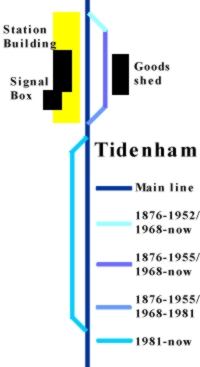
|
| Netherhope Halt | 18/ 06/ 1932 | 05/ 01/ 1959 | Never accepted |
Netherhope consists of a small number of houses along the Netherhope Road. The halt also served the upper end of Tidenham (which was more convenient for Netherhope Halt than Tidenham station) and various dwellings in Tidenham Chase, on the hill above Tidenham Tunnel. Traffic - Passengers Trackwork - 1 earth platform with wooden edging and wall |
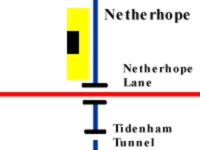
|
| Tintern | 01/ 11/ 1876 | 05/ 01/ 1959 | 06/ 01/ 1964 |
Possesed the only crossing loop on the branch. Tintern was deemed to be the most substantial village and (evidently, given the station's location a mile up the road) the most likely to expand. Frequently served by tours bringing people to see Tintern Abbey. These tours tended to use the third platform. A Camp Coach was sited here during the late 1930s and 1950s Traffic - Passengers, mail, general goods, livestock Trackwork - 3 stone platforms, sidings, cattle dock Renamed Tintern for Brockweir in 1912. This was translated onto the official map as Tintern for Blockley (Blockley is in east Gloucestershire, whereas Brockweir is one of the farthest west places in the same county). The reference to Brockweir was dropped with the opening of its halt. |
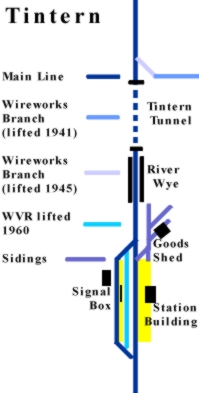
|
| Brockweir Halt | 23/ 09/ 1929 | 05/ 01/ 1959 | Never accepted |
On the other bank of the river to Brockweir, but linked by a 1906-built road bridge. Occasionally flooded. Traffic - Passengers Trackwork - 1 earth platform with wooden edging and wall |

|
| Llandogo Halt | 07/ 03/ 1927 | 05/ 01/ 1959 | Never accepted |
Had it been built with the line instead of St Briavals it would have had freight facilities. As it was, the smallest of the three sizeable villages in the Lower Wye Valley (the others being Tintern and Redbrook) had no stop of its own until 1927. Traffic - Passengers Trackwork - 1 earth platform with wooden edging and wall |
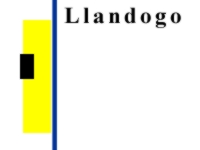
|
| St Briavels | 01/ 11/ 1876 | 05/ 01/ 1959 | 05/01/1959 |
Still mostly in situ, although signalbox demolished. Traffic - Passengers, mail, general goods, salmon, livestock. Nearest centre of population was a mile away. Largely appears to have been intended to pick up traffic at a road junction adjacent to the river. Originally named Bigsweir. This was amended to St Briavels and Llandogo in 1909. The name was reduced to plain St Briavels in 1927. Trackwork - 1 stone platform, loop, sidings |

|
| Whitebrook Halt | 01/ 02/ 1927 | 05/ 01/ 1959 | Never accepted |
First halt to open. Served the remote village of Whitebrook. Traffic - Passengers. Also home to a level crossing, complete with crossing keeper's house, which provided access to some fields and the riverbank. In the 1870s it was the railhead for the Whitebrook paper mills. It does not appear that the paper mills were ever given a siding. Trackwork - 1 earth platform with wooden edging and wall |
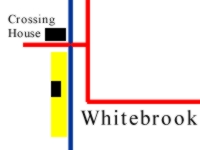
|
| Penallt Halt | 01/ 08/ 1931 | 05/ 01/ 1959 | Never accepted |
Adjacent to the Boat Inn so even though it did not formally accept freight the occasional barrel of ale would be off-loaded here Traffic - Passengers, ale (unofficial) Penallt was a mile away at the top of the hill. There are only a few surrounding houses. The nearest centre of population was Redbrook. Trackwork - 1 wooden trestle platform |
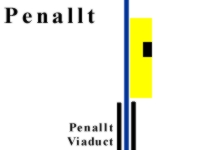
|
| Redbrook | 01/ 11/ 1876 | 05/ 01/ 1959 | 06/ 01/ 1964 |
Near Redbrook tinplate works so it had a regular supply of freight until 1961 when the works shut Holds the record for the least trace left of any station on the line. Traffic - Passengers, mail, general goods, tin Located at the northern end of the village of Redbrook, so convenient for the local populace. Re-named Redbrook-on-Wye in 1933. Trackwork - 1 stone platform, loop outside station, sidings |
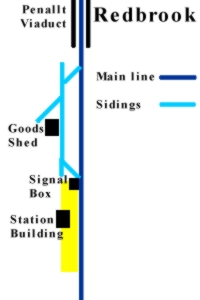
|
| Wyesham Halt | 12/ 01/ 1931 | 05/ 01/ 1959 | Never accepted |
Built near the site of Wyesham Junction No trace remaining today although the viaduct into Monmouth starts just yards away and the A466 still drops down to pass under the railway at this point even though the bridge was removed completely in the 1960s. The halt was a few hundred yards north of the actual northern end of Wye Valley Railway metals. Trains ran from there over the metals of the Coleford, Monmouth, Usk and Pontypool Railway to access Monmouth Troy. Traffic - Passengers Trackwork - 1 wooden trestle platform |
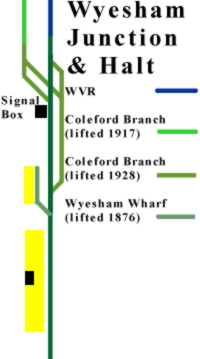
|
| Monmouth Troy | 12/ 10/ 1857 | 05/ 01/ 1959 | 06/ 01/ 1964 |
Not formally on the line. The Wye Valley was just a branch off the main route from Ross to Pontypool and the junction was here. Services were inaugrated by the Coleford, Monmouth, Usk and Pontypool Railway in 1857. The station was a terminus; trains only ran through Monmouth Tunnel to Pontypool. An extension to Wyesham was added in 1861. Trackwork was modified to allow the Ross and Monmouth to begin services in 1874. WVR trains began running in over the Wyesham extension in 1876. Second largest station in terms of platforms (2) Well out of Monmouth, although 1930s expansion saw the town develop to be closer to the station. The direct and simple access along a suburban road on the south bank of the River Monnow has now been broken by the construction of the A449/A40 expressway. Footbridge removed in the Spring of 1957. Traffic - Passengers, mail, general goods. Coal was later taken by lorry. There was a sawmill adjacent to the siding at the west end of the tunnel. Somehow managed to avoid complete closure until 12 October 1964. This is an official detail but rather silly as the station hadn't accepted any traffic for ten months. This was probably the date of closure of the booking office (it apparently remained open for some time) and the refreshment room. Trackwork at peak - 2 stone platforms, sidings, crossovers and double track junction. |
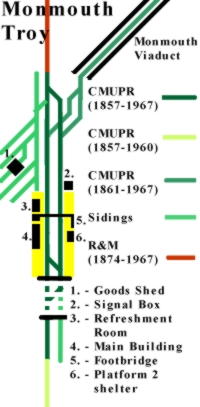
|
|
|
|